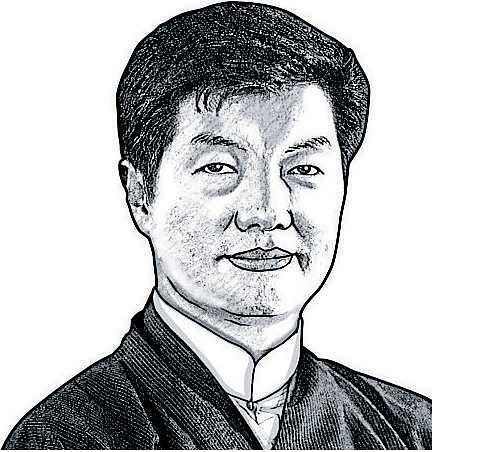Lobsang Sangay, a Fulbright Scholar and an alumnus of the Harvard Law School, was elected as head of the Tibetan Government-in-Exile (TGiE) – formally known as Central Tibetan Administration–in 2011 and re-elected in 2016. As India’s military stand-off with China in eastern Ladakh turned violent in Galwan Valley on June 15, the Sikyong (President) of the TGiE tells the DH that all democratic nations should come together to resist the Communist country’s bid to dismantle the rules-based world order. He spoke to Anirban Bhaumik of DH.
Excerpts:
How do you view the recent aggression by China along its disputed boundary with India?
India’s late Defence Minister George Fernandes had said that China is India’s Number One potential threat. He even warned of China’s “String of Pearls” strategy to encircle India. What we are now seeing on the China’s Line of Actual Control (LAC) with India as well as in the Indian Ocean confirms what he had said two decades ago. Twenty Indian Army soldiers lost their lives protecting India’s borders against China’s aggression. There was no border conflict in the Himalayas 70 years ago, because Tibet served as a natural buffer between the two Asian giants – China and India.
By invading Tibet, China turned that buffer zone into a strategic upper hand for its People’s Liberation Army to implement its expansionist dreams. China is now coming after what Mao Zedong described as Tibet’s “Five Fingers” – Ladakh, Sikkim, Arunachal Pradesh, Bhutan and Nepal. China promised to bring prosperity and stability in Tibet. But it sent its trucks, guns and tanks to occupy Tibet and plunder the mineral resources of Tibet. What it did with Tibet revealed China’s increasing military expansionist policy in Asia. We have been saying for the last 70 years that what happened to Tibet could happen to all the neighbouring countries of Tibet, including India.
How do you think India should respond to the aggression by China?
Tibet lies at the core of the territorial dispute between India and China since the Indo-Tibet border turned into Sino-Indian border in 1954. Since China’s invasion of Tibet in 1950, China is trying to expand its geopolitical ambitions. China’s military aggressions along its Himalayan borders with India are just a tip of the iceberg. Until you solve the issue of Tibet, China’s military incursion across its border with India will continue. A resolution to the Tibet issue by restoring Tibet to its traditional status of peace zone is imperative for Asia’s geopolitical stability and peace. The Central Tibetan Administration, the exile Tibetan Administration, has been pursuing the peaceful resolution of Tibet issue through the Middle Way Approach that seeks to demilitarise Tibet and make Tibet a peace zone. If Tibet is demilitarised, there wouldn’t be any issue over the border. So, making Tibet a peace zone is in the interest of peace and stability of Asia.
We can see China’s aggression in East China Sea, South China Sea and Taiwan Strait too. Why do you think China is pursuing such an aggressive policy?
Amid a global backlash over its severe mishandling of Covid-19 coupled with insecurities and fears emanating from growing internal tensions, the Communist Party of China is trying to obfuscate the international scrutiny by raking up maritime disputes, imposing legal crackdown in Hong Kong and military provocations with India. From seeking to overturn Hong Kong’s ‘one country, two systems’ with the new national security laws to stirring maritime disputes in the South China Sea and East China Sea and browbeating Taiwan, China is going all out in advancing its grand geopolitical strategy to become the ultimate global hegemony unilaterally.
The world is no stranger to China’s brazen disregard for international law when laying claim to new territory. China has claimed that Tibet was a part of its territory for centuries, even though historically and legally, Tibet has been an independent country until it was forcefully occupied in 1950. The same blueprint is now applying to the South Asian countries such as Nepal, Bhutan and India as well as in the East China Sea, South China Sea, Taiwan and Hong Kong. China is trying to change the status quo by using its military power and violating international laws. Even in this Covid-19 era, China is capitalising the global health crisis to serve its own political interest, instead of joining the world to fight the pandemic collectively.
How should the international community respond to new aggression of China?
It will require a multilateral front to respond to mishandling of powers by China. The democratic countries around the world must forge an alliance to systematically counter the economic and military intimidations by China and reset its relations with Xi Jinping’s regime in Beijing on every front. The world can no longer hope that China will someday play by the rules because it clearly never did and never will. Tibetans have been saying this for the past 70 years and, if the world still continues to ignore it, China will soon dismantle the rules-based world order to impose its very own draconian system globally.
What is the situation in Tibet, particularly during this Covid-19 crisis?
The authorities are using the Covid-19 outbreak to propagate the Communist party’s drive to enhance “party’s stability” and “social stability maintenance”, intensifying crackdown on Tibetans, introducing drastic surveillance measures in every Tibetan district, schools, monasteries and personal spaces. During the Tibetan New Year festival in February and during the month of Buddha Purnima in May, Tibetans were not allowed to visit monasteries.

